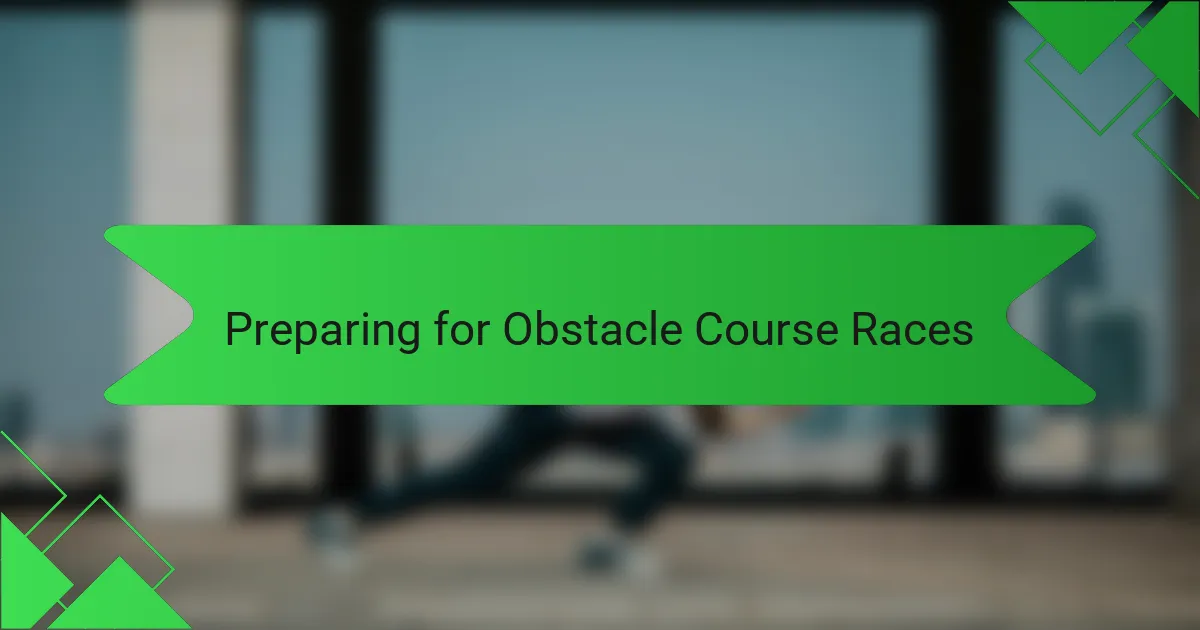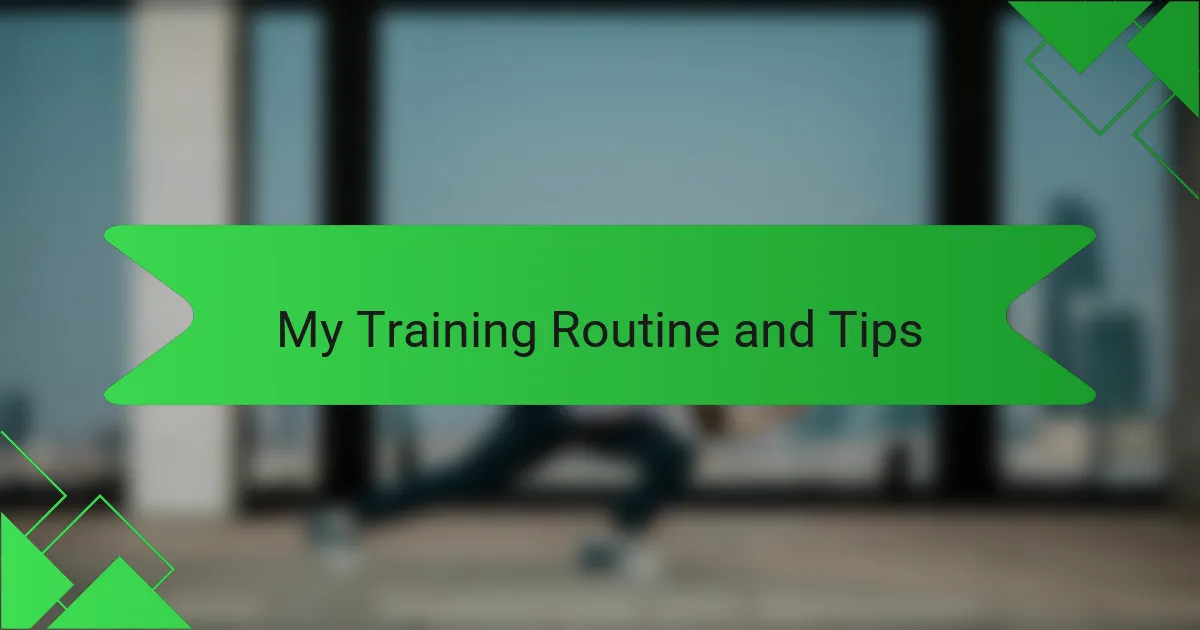Key takeaways
- Obstacle course racing enhances physical fitness, mental resilience, and problem-solving skills, transforming workouts into engaging adventures.
- Girl Scouts Fitness Challenges foster camaraderie, perseverance, and the importance of setting achievable goals, helping participants push past their limits.
- A balanced training routine that incorporates endurance, strength, and flexibility, combined with mental preparation, is crucial for success in obstacle course racing.
- Tracking small victories during training boosts confidence and motivation, highlighting the importance of celebrating progress in fitness journeys.

Understanding Obstacle Course Racing
Obstacle course racing isn’t just a test of speed; it challenges your strength, agility, and mental grit all at once. When I first faced a muddy climb and slippery rope, I wondered if I could really push through the discomfort—and that moment of doubt pushed me further than I expected. Have you ever felt that mix of fear and excitement as you approach a new challenge? That’s the essence of obstacle course racing.

Benefits of Obstacle Course Racing
Obstacle course racing has been a game-changer for my fitness and confidence. It’s not just about running fast—it forces you to engage every muscle and think on your feet. I remember gripping a cold rope, feeling my heart race, and realizing how much stronger I’d become both physically and mentally.
One thing I noticed is how OCR pushes you beyond your limits without feeling like a boring workout. The thrill of conquering each obstacle keeps you motivated, turning fitness into an adventure rather than a chore. Have you ever felt that rush after beating a tough challenge? That’s the fuel that keeps me coming back.
Beyond building strength and endurance, obstacle course racing also sharpens problem-solving skills. Each course demands quick decisions and adaptability, which translate well into everyday life. For me, that mental edge is just as rewarding as crossing the finish line.

Overview of Girl Scouts Fitness Challenges
The Girl Scouts Fitness Challenges are designed to inspire girls to embrace physical activity in a fun and empowering way. I remember lacing up my sneakers for the first time, feeling a mix of curiosity and excitement about what I was about to try. These challenges aren’t about perfection—they’re about showing up and trying your best.
Each challenge focuses on building different areas of fitness, like endurance, strength, and flexibility. From jumping jacks to timed runs, I found myself pushing past limits I never thought I had. Have you ever surprised yourself by doing something you thought was out of reach? That’s exactly what these challenges bring out.
What struck me most was how the challenges created a sense of camaraderie and support among the scouts. Even when a task felt tough, knowing others were cheering you on made a huge difference. In many ways, these fitness challenges laid the groundwork for the mental toughness I later needed in obstacle course racing.

Preparing for Obstacle Course Races
Preparing for obstacle course races means more than just pounding the pavement or lifting weights. I learned early on that blending different types of training—like endurance runs, strength exercises, and even flexibility drills—makes all the difference when facing unpredictable obstacles. Have you ever found that focusing on just one kind of workout left you unprepared for the variety of challenges on race day? That’s exactly what hit me when I first tried to climb a slippery wall without enough upper-body strength.
I also discovered that mental preparation is key. Before races, I’d practice visualization and set small goals for each obstacle, which kept me focused and calm when the course got tough. It’s amazing how much the right mindset can push you through exhaustion and frustration. Can you recall a moment when believing in yourself helped you power through something you didn’t think you could do? For me, this mental training was just as important as physical fitness.
Finally, I can’t overstate the value of consistency and gradual progress. Trying to do too much too soon only led to burnout and injury in my experience. Instead, I broke down the training into manageable steps and celebrated small victories along the way. This approach made preparing for races feel less intimidating and more like a series of achievable challenges. Have you ever noticed how steady progress not only improves your skills but also keeps your motivation alive? That steady rhythm became my secret weapon.

My Training Routine and Tips
Consistency has been my cornerstone in training. I found that dedicating specific days to endurance, strength, and flexibility kept me balanced and prevented burnout. Do you ever notice how juggling everything at once just drains your energy? Breaking it into focused sessions changed the game for me.
Incorporating what I learned from Girl Scouts’ fitness challenges, I make sure to mix fun into my routine. For example, turning a strength workout into a game or challenging myself with a timed obstacle course simulation keeps boredom at bay. Have you tried turning workouts into playful challenges? It makes pushing through tough sets feel a lot less like a chore.
One practical tip I swear by is tracking small wins, no matter how minor they seem. Whether it’s holding a plank a few seconds longer or shaving time off a run, celebrating those moments boosted my confidence exponentially. How often do you pause to acknowledge your progress? From my experience, those little victories fuel the motivation needed to tackle the next challenge.

Lessons Learned from Girl Scouts
Reflecting on my time with the Girl Scouts, one lesson that stands out is the value of perseverance. I remember struggling through a particularly tough fitness challenge, wondering if I should just give up. But pushing through that moment taught me that determination often matters more than natural talent.
Another key takeaway was learning to embrace teamwork and encouragement. During those challenges, it wasn’t just about personal achievement; the support from fellow scouts fueled my drive. Have you ever noticed how a simple cheer or shared effort can transform a difficult task into something manageable? That sense of community really shaped my approach to racing and training.
Finally, Girl Scouts helped me appreciate the importance of setting small, achievable goals. Instead of getting overwhelmed by the big picture, focusing on incremental progress made every challenge feel doable. I still apply this mindset today—breaking down an obstacle course into bite-sized steps keeps me motivated and confident. Doesn’t tackling one step at a time make even the toughest challenges feel within reach?
